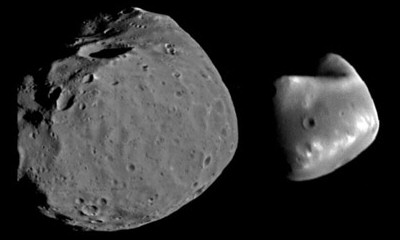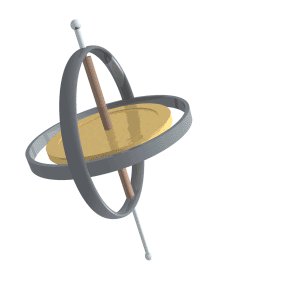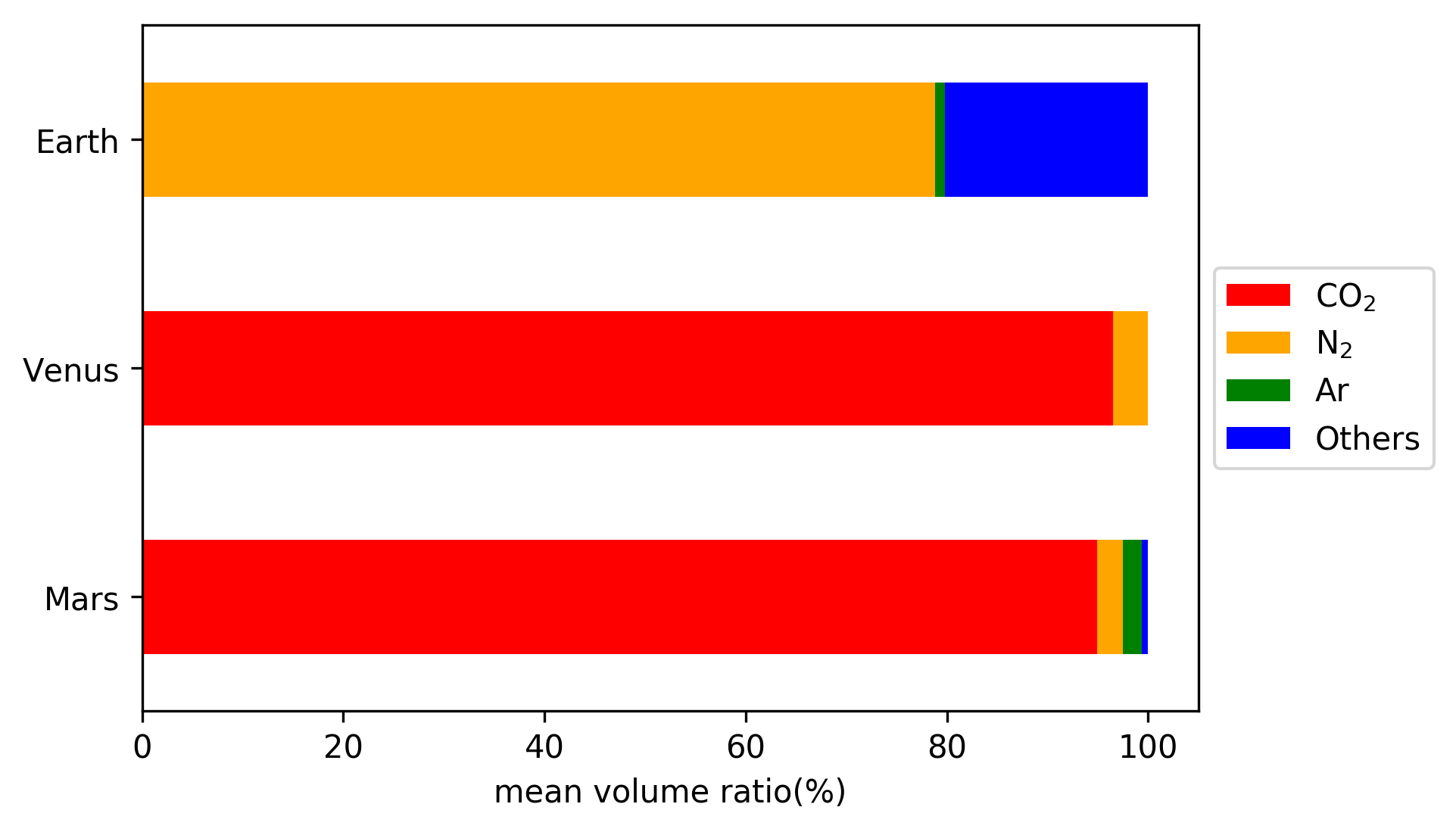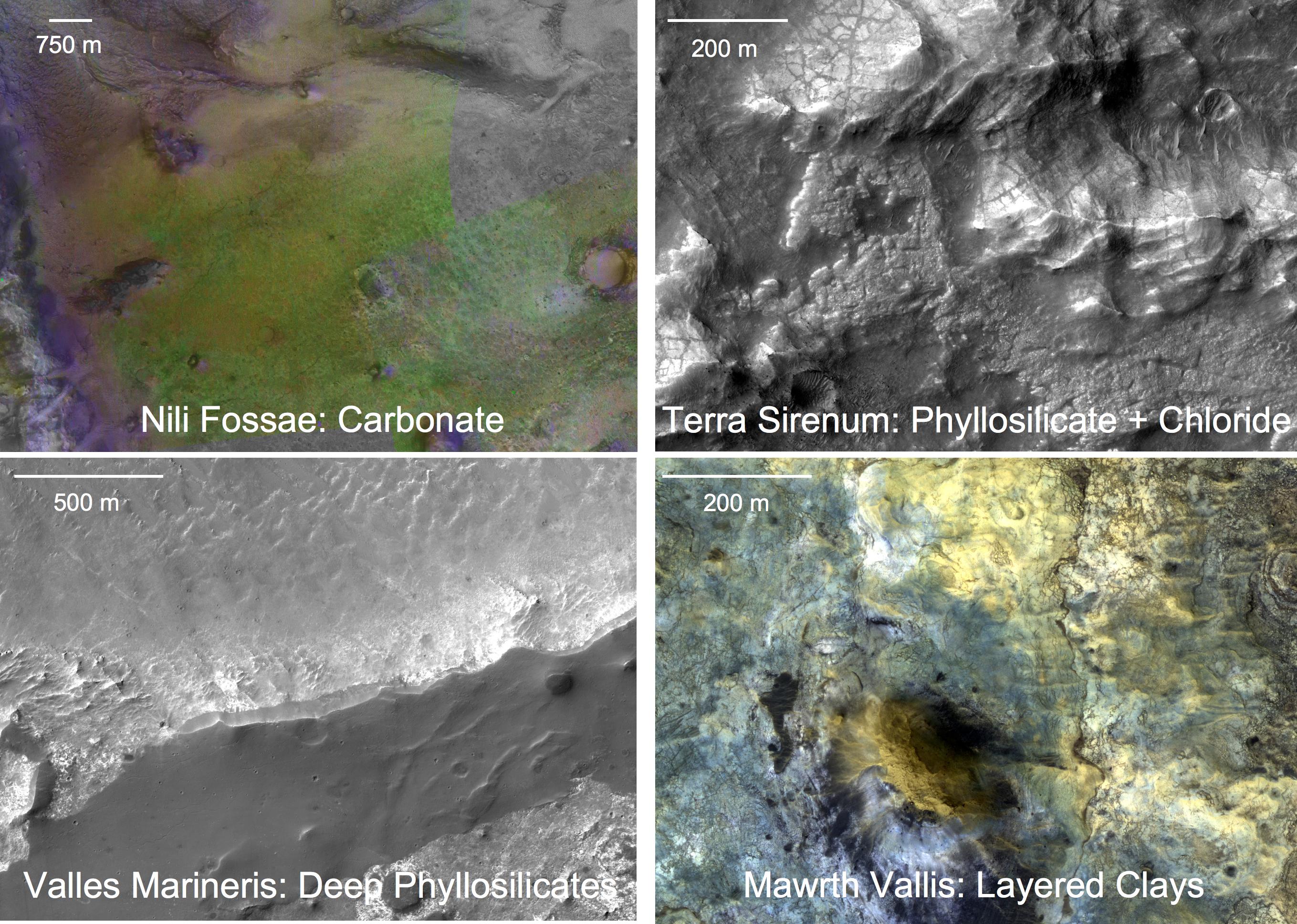|
Martian Hemispheric Dichotomy
The Martian dichotomy, is a geomorphical feature of Mars, characterized by the contrast between the Southern and the Northern hemispheres. The two hemispheres' geography differ in elevation by 1 to 3 km. The average thickness of the Martian crust is 45 km, with 32 km in the northern lowlands region, and 58 km in the southern highlands. The boundary between the two regions is quite complex in places. One distinctive type of topography is called fretted terrain. It contains mesas, knobs, and flat-floored valleys having walls about a mile high. Around many of the mesas and knobs are lobate debris aprons that have been shown to be rock glaciers. Many large valleys formed by the lava erupted from the volcanoes of Mars cut through the dichotomy. The Martian dichotomy boundary includes the regions called Deuteronilus Mensae, Protonilus Mensae, and Nilosyrtis Mensae. All three regions have been studied extensively because they contain landforms believed t ... [...More Info...] [...Related Items...] OR: [Wikipedia] [Google] [Baidu] |
Mars Topography (MOLA Dataset) With Poles HiRes
Mars is the fourth planet from the Sun. It is also known as the "Red Planet", because of Mars surface color, its orange-red appearance. Mars is a desert-like rocky planet with a tenuous carbon dioxide () Atmosphere of Mars, atmosphere. At the average surface level the atmospheric pressure is a few thousandths of Earth's, atmospheric temperature ranges from and cosmic radiation is high. Mars retains some water, Groundwater on Mars, in the ground as well as thinly in the atmosphere, forming cirrus clouds, frost, larger polar regions of permafrost and Martian polar ice caps, ice caps (with seasonal snow), but no liquid surface water. Its surface gravity is roughly a third of Earth's or double that of the Moon. It is half List of Solar System objects by size, as wide as Earth or twice the Moon, with a diameter of , and has a surface area the size of all the dry land of Earth. Martian regolith#Atmospheric dust, Fine dust is prevalent across the surface and the atmosphere, bein ... [...More Info...] [...Related Items...] OR: [Wikipedia] [Google] [Baidu] |
North Polar Basin (Mars)
The North Polar Basin, more commonly known as the Borealis Basin, is a large basin in the northern hemisphere of Mars that covers 40% of the planet. Some scientists have postulated that the basin formed during the impact of a single, large body roughly 2% of the mass of Mars, having a diameter of about 1,900 km (1,200 miles) early in the history of Mars, around 4.5 billion years ago. However, the basin is not currently recognized as an impact basin by the IAU. The basin is one of the flattest areas in the Solar System, and has an elliptical shape. Large regions within the Borealis Basin Because the Borealis basin covers 40% of the surface of Mars, and much of the Northern Hemisphere, many currently recognized regions of Mars lie within it: * Acidalia Planitia * Arcadia Planitia * Planum Boreum * Utopia Planitia * Vastitas Borealis Borealis Impact Formation of the Borealis Basin One possible explanation for the basin's low, flat and relatively crater-free to ... [...More Info...] [...Related Items...] OR: [Wikipedia] [Google] [Baidu] |
Hadley Circulation
The Hadley cell, also known as the Hadley circulation, is a global-scale tropical atmospheric circulation that features air rising near the equator, flowing poleward near the tropopause at a height of above the Earth's surface, cooling and descending in the subtropics at around 25 degrees latitude, and then returning equatorward near the surface. It is a thermally direct circulation within the troposphere that emerges due to differences in insolation and heating between the tropics and the subtropics. On a yearly average, the circulation is characterized by a circulation cell on each side of the equator. The Southern Hemisphere Hadley cell is slightly stronger on average than its northern counterpart, extending slightly beyond the equator into the Northern Hemisphere. During the summer and winter months, the Hadley circulation is dominated by a single, cross-equatorial cell with air rising in the summer hemisphere and sinking in the winter hemisphere. Analogous circulations ... [...More Info...] [...Related Items...] OR: [Wikipedia] [Google] [Baidu] |
Orbital Eccentricity
In astrodynamics, the orbital eccentricity of an astronomical object is a dimensionless parameter that determines the amount by which its orbit around another body deviates from a perfect circle. A value of 0 is a circular orbit, values between 0 and 1 form an elliptic orbit, 1 is a parabolic escape orbit (or capture orbit), and greater than 1 is a hyperbola. The term derives its name from the parameters of conic sections, as every Kepler orbit is a conic section. It is normally used for the isolated two-body problem, but extensions exist for objects following a rosette orbit through the Galaxy. Definition In a two-body problem with inverse-square-law force, every orbit is a Kepler orbit. The eccentricity of this Kepler orbit is a non-negative number that defines its shape. The eccentricity may take the following values: * Circular orbit: * Elliptic orbit: * Parabolic trajectory: * Hyperbolic trajectory: The eccentricity is given by e = \sqrt where ... [...More Info...] [...Related Items...] OR: [Wikipedia] [Google] [Baidu] |
Apsis
An apsis (; ) is the farthest or nearest point in the orbit of a planetary body about its primary body. The line of apsides (also called apse line, or major axis of the orbit) is the line connecting the two extreme values. Apsides pertaining to orbits around different bodies have distinct names to differentiate themselves from other apsides. Apsides pertaining to geocentric orbits, orbits around the Earth, are at the farthest point called the ''apogee'', and at the nearest point the ''perigee'', like with orbits of satellites and the Moon around Earth. Apsides pertaining to orbits around the Sun are named ''aphelion'' for the farthest and ''perihelion'' for the nearest point in a heliocentric orbit. Earth's two apsides are the farthest point, ''aphelion'', and the nearest point, ''perihelion'', of its orbit around the host Sun. The terms ''aphelion'' and ''perihelion'' apply in the same way to the orbits of Jupiter and the other planets, the comets, and the asteroids of t ... [...More Info...] [...Related Items...] OR: [Wikipedia] [Google] [Baidu] |
Solstice
A solstice is the time when the Sun reaches its most northerly or southerly sun path, excursion relative to the celestial equator on the celestial sphere. Two solstices occur annually, around 20–22 June and 20–22 December. In many countries, the seasons of the year are defined by reference to the solstices and the equinoxes. The term ''solstice'' can also be used in a broader sense, as the day when this occurs. For locations not too close to the equator or the poles, the dates with the longest and shortest periods of daylight are the summer and winter solstices, respectively. Terms with no ambiguity as to which hemisphere is the context are "June solstice" and "December solstice", referring to the months in which they take place every year. Etymology The word ''solstice'' is derived from the Latin () and (), because at the solstices, the Sun's declination appears to "stand still"; that is, the seasonal movement of the Sun's sun path, daily path (as seen from Earth) paus ... [...More Info...] [...Related Items...] OR: [Wikipedia] [Google] [Baidu] |
Precession
Precession is a change in the orientation of the rotational axis of a rotating body. In an appropriate reference frame it can be defined as a change in the first Euler angle, whereas the third Euler angle defines the rotation itself. In other words, if the axis of rotation of a body is itself rotating about a second axis, that body is said to be precessing about the second axis. A motion in which the second Euler angle changes is called '' nutation''. In physics, there are two types of precession: torque-free and torque-induced. In astronomy, ''precession'' refers to any of several slow changes in an astronomical body's rotational or orbital parameters. An important example is the steady change in the orientation of the axis of rotation of the Earth, known as the precession of the equinoxes. Torque-free or torque neglected Torque-free precession implies that no external moment (torque) is applied to the body. In torque-free precession, the angular momentum is a constant, ... [...More Info...] [...Related Items...] OR: [Wikipedia] [Google] [Baidu] |
Atmosphere Of Mars
The atmosphere of Mars is the layer of gases surrounding Mars. It is primarily composed of carbon dioxide (95%), molecular nitrogen (2.85%), and argon (2%). It also contains trace levels of water vapor, oxygen, carbon monoxide, hydrogen, and noble gases. The atmosphere of Mars is much thinner and colder than Atmosphere of Earth, Earth's having a max density 20 g/m3 (about 2% of Earth’s value) with a temperature generally below zero down to –60 °C. The average Atmospheric pressure, surface pressure is about which is 0.6% of the Earth's value. The currently thin Martian atmosphere prohibits the existence of liquid water on the surface of Mars, but many studies suggest that the Martian atmosphere was much thicker in the past. The higher density during spring and fall is reduced by 25% during the winter when carbon dioxide partly freezes at the pole caps. The highest atmospheric density on Mars is equal to the density found above the Earth's surface and is ≈0.020 kg/m3 ... [...More Info...] [...Related Items...] OR: [Wikipedia] [Google] [Baidu] |
Hesperian
The Hesperian is a system (stratigraphy), geologic system and geologic timescale, time period on the planet Mars characterized by widespread Volcanology of Mars, volcanic activity and catastrophic flooding that carved immense outflow channels across the surface. The Hesperian is an intermediate and transitional period of Martian history. During the Hesperian, Mars changed from the wetter and perhaps warmer world of the Noachian (Mars), Noachian to the dry, cold, and dusty planet seen today. The absolute age of the Hesperian Period is uncertain. The beginning of the period followed the end of the Late Heavy Bombardment and probably corresponds to the start of the lunar Late Imbrian period, around 3700 million years ago (Myr, Mya). The end of the Hesperian Period is much more uncertain and could range anywhere from 3200 to 2000 Mya, with 3000 Mya being frequently cited. The Hesperian Period is roughly coincident with the Earth's early Archean Eon. With the decline of heavy impacts a ... [...More Info...] [...Related Items...] OR: [Wikipedia] [Google] [Baidu] |
Noachian
The Noachian is a system (stratigraphy), geologic system and early geologic timescale, time period on the planet Mars characterized by high rates of meteorite and asteroid Impact event, impacts and the possible presence of abundant surface water. The absolute age of the Noachian period is uncertain but probably corresponds to the lunar Pre-Nectarian to Early Imbrian periods of 4100 to 3700 million years ago, during the interval known as the Late Heavy Bombardment. Many of the large impact basins on the Moon and Mars formed at this time. The Noachian Period is roughly equivalent to the Earth's Hadean and early Archean eons when Earth's first life forms likely arose. Noachian-aged terrains on Mars are prime Lander (spacecraft), spacecraft landing sites to search for fossil evidence of extraterrestrial life, life. During the Noachian, the atmosphere of Mars was denser than it is today, and the climate possibly warm enough (at least episodically) to allow rainfall. Large lakes and riv ... [...More Info...] [...Related Items...] OR: [Wikipedia] [Google] [Baidu] |
Early Bombardment Phase
There is evidence that the formation of the Solar System began about 4.6 billion years ago with the gravitational collapse of a small part of a giant molecular cloud. Most of the collapsing mass collected in the center, forming the Sun, while the rest flattened into a protoplanetary disk out of which the planets, moons, asteroids, and other small Solar System bodies formed. This model, known as the nebular hypothesis, was first developed in the 18th century by Emanuel Swedenborg, Immanuel Kant, and Pierre-Simon Laplace. Its subsequent development has interwoven a variety of scientific disciplines including astronomy, chemistry, geology, physics, and planetary science. Since the dawn of the Space Age in the 1950s and the discovery of exoplanets in the 1990s, the model has been both challenged and refined to account for new observations. The Solar System has evolved considerably since its initial formation. Many moons have formed from circling discs of gas and dust around their par ... [...More Info...] [...Related Items...] OR: [Wikipedia] [Google] [Baidu] |
Plate Tectonics
Plate tectonics (, ) is the scientific theory that the Earth's lithosphere comprises a number of large tectonic plates, which have been slowly moving since 3–4 billion years ago. The model builds on the concept of , an idea developed during the first decades of the 20th century. Plate tectonics came to be accepted by Earth science, geoscientists after seafloor spreading was validated in the mid-to-late 1960s. The processes that result in plates and shape Earth's crust are called ''tectonics''. Tectonic plates also occur in other planets and moons. Earth's lithosphere, the rigid outer shell of the planet including the crust (geology), crust and upper mantle, is fractured into seven or eight major plates (depending on how they are defined) and many minor plates or "platelets". Where the plates meet, their relative motion determines the type of plate boundary (or fault (geology), fault): , , or . The relative movement of the plates typically ranges from zero to 10 cm annu ... [...More Info...] [...Related Items...] OR: [Wikipedia] [Google] [Baidu] |








